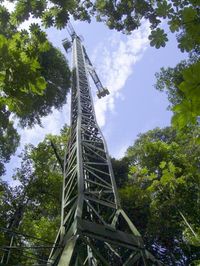Inquiries
Long-term community dynamics
Vascular epiphytes: Long-term community dynamics

Tropical forests harbor a stunning biological diversity, and the question of the origins and maintenance of this diversity is a central topic in modern ecology. A large proportion of the plant and animal species are found in the forest canopy, and any general theory on biodiversity and community assembly should thus be applicable to canopy-dwelling organisms such as vascular epiphytes. Is community assembly a deterministic process or largely a matter of chance? This central question is addressed in an on-going study financed by the Deutsche Forschungsgemeinschaft, which consists of both descriptive and experimental elements. Taking advantage of initial census work more than a decade ago, we no directly document temporal and spatial dynamics of complex epiphyte communities and use transplant and ecophysiological experiments to come to a mechanistic understanding of the processes that allow for the co-occurrence of up to 80 epiphyte species on a single tree. Access is possible by either studying epiphytes on host trees of small stature (Annona glabra) or by the use of a tower crane in primary lowland forest. The first site is located in the Barro Colorado Nature Monument, the second is near San Lorenzo in Panama. Both sites are administered by the Smithsonian Tropical Research Institute. Information on the crane site can be found here.
Selected publications
Mendieta Leiva G, Buckley HL & Zotz G. 2022. Directional changes over time in the species composition of tropical vascular epiphyte assemblages. Journal of Ecology 110: 553–568. https://doi.org/10.1111/1365-2745.13817
Petter G, Kreft H, Zotz G & Cabral JS. 2021. Agent-based modelling of the effects of forest dynamics, selective logging and fragment size on epiphyte communities. Ecology and Evolution 11: 2937–2951. https://doi.org/10.1002/ece3.7255
Janzen T, Zotz G & Etienne RS. 2020. Community structure of vascular epiphytes: a neutral perspective. Oikos 129: 853–867. https://doi.org/10.1111/oik.06537
Spruch L, Hellwig J, Zotz G & Blasius B. 2019. Modelling community assembly on growing habitat “islands”: A case study on trees and their vascular epiphyte communities. Theoretical Ecology 12: 513–529. https://doi.org/10.1007/s12080-019-0425-4
Einzmann HJR, Weichgrebe L & Zotz G. 2021. Long-term community dynamics in vascular epiphytes on Annona glabra along the shoreline of Barro Colorado Island, Panama. Journal of Ecology 109: 1931-1946.
Einzmann HJR & Zotz G. 2017. “No signs of saturation”: Long-term dynamics of vascular epiphyte communities in a human-modified landscape. Biodiversity and Conservation 26: 1393-1410.
Wagner K & Zotz G. 2020. Including dynamics in the equation: Tree growth rates and host specificity of vascular epiphytes. Journal of Ecology 108: 761-773.
Burns KC & Zotz G. 2010. A hierarchical framework for investigating epiphyte assemblages: networks, metacommunities and Scale. Ecology 91: 377-385.
Zotz G & Schultz S. 2008. The vascular epiphytes of a lowland forest in Panama - species composition and spatial structure. Plant Ecology 195: 131-141.
Zotz G. 2007. The population structure of the vascular epiphytes in a lowland forest in Panama correlates with species abundance. Journal of Tropical Ecology 23: 337-342.
Laube S & Zotz G. 2007. A metapopulation approach to the analysis of long-term changes in the epiphyte vegetation on the host tree Annona glabra. Journal of Vegetation Science 18: 613-624.
Co-operation
S. Joseph Wright, Smithsonian Tropical Research Institute, Panama



